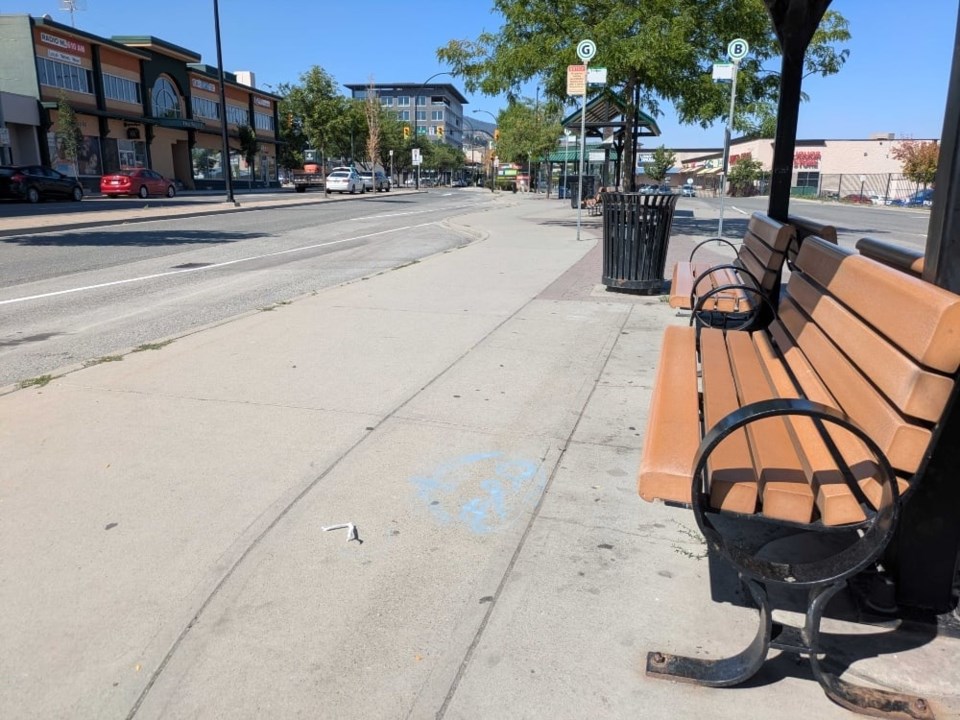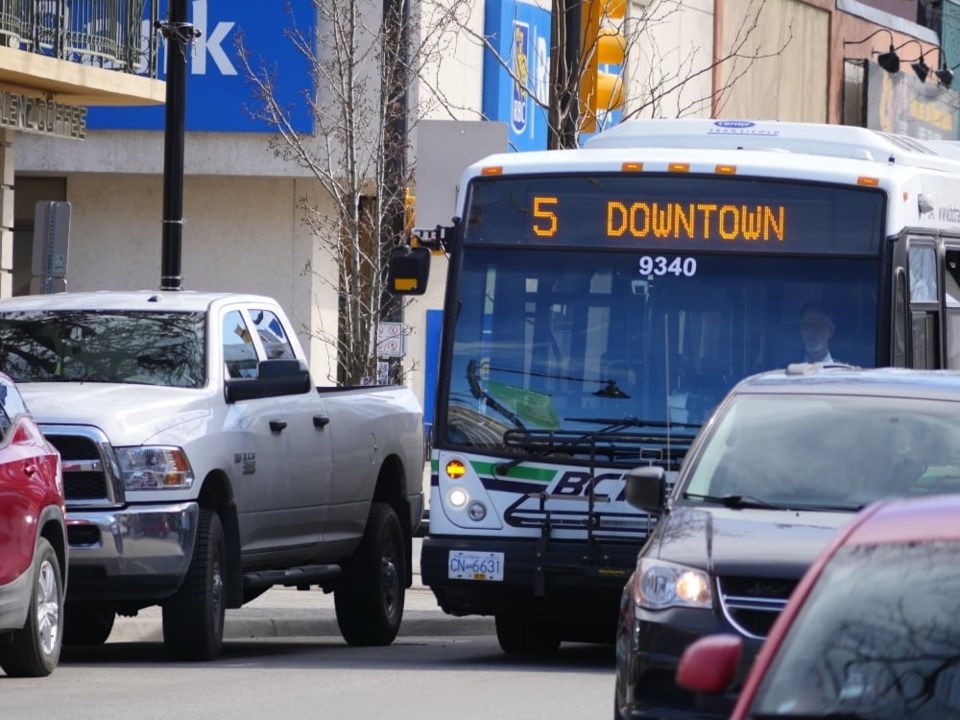This story was first published in The Tyee. You can subscribe to their daily email here.
Catching a bus in a mid-sized British Columbia city can be a trying experience. Buses arrive and depart at sporadic times and tend to disappear on evenings and weekends.
But as B.C.’s local governments try to improve their cities’ transit options, they have been told the province doesn’t have enough money to pay its share.
That has left local politicians upset and increasingly pointing out that a key plank in the province’s housing strategy is being undermined by a lack of funding for local buses.
In Penticton, Coun. Isaac Gilbert said the lack of funding for his city’s transit ambitions flew in the face of the province’s own housing policies.
At a council meeting this spring, Gilbert said he was “super disappointed with the province coming in with sweeping mandates to tell cities what to do but not bringing the resources in.”
He’s not the only one. Local politicians in Chilliwack, Kamloops and Mission have all shared similar concerns. They have expressed frustration after the province has partially or completely rejected projects that would have bolstered bus service in the communities.
The cities all have “transit-oriented development areas” — legislated areas within 400 metres of bus exchanges where the cities are forbidden from imposing minimum parking requirements on new housing projects. Provincial legislation passed in 2023 aims to promote the development of multi-storey, dense neighbourhoods around such areas.
Parking requirements create a barrier to the development of new housing, add to building costs and reduce “the incentive for the public to use transit,” according to the province. The idea is that residents in such “transit-oriented” areas can use transit to get to work and access services.
But the actual transit systems in many of the cities is lacklustre — or, in the case of Kamloops, so well used that buses don’t have enough space to meet the demand.
In recent years, cities and BC Transit have jointly crafted plans to expand bus service. But because cities outside of Metro Vancouver and the TransLink region roughly split the cost of standard bus service with the province, any expansion also needs money from the provincial government.
And although the municipalities have committed to paying for more buses, the province has provided only a fraction of the money necessary.
Since 2023, B.C.’s municipalities have committed to funding the operation of more than 100 additional buses and a total 453,540 hours of new bus service. But the province has provided matching funds for less than half that total, according to figures BC Transit provided to The Tyee.
In 2023-24, the province refused to fund any transit expansions. Last year, it provided only enough money to add two-thirds of the new buses requested.
For the current 2025-26 fiscal year, cities got only half the transit expansions they sought. Although provincial funding for expansions did increase from 2024-25, the demand from cities has grown at an even faster rate.
This year, municipalities had requested matching funding to add 119 buses to their fleets. The province approved funding for just 56 new vehicles.
The Tyee obtained approval and rejection letters sent to dozens of municipal government officials across B.C. They can be read here.
We also obtained the evaluation criteria used to prioritize expansion proposals. Those are here.
BC Transit noted that funding decisions do not depend entirely on the evaluation chart. The Tyee’s examination of the chart and funding letters shows some high-ranking expansion proposals did not receive money while projects with slightly lower scores did get approval.

‘It’s quite unfair’
Gilbert told The Tyee that he and his colleagues on Penticton council have supported efforts to increase density in cities. He said Penticton, where development is limited by the lakes and mountains that surround it, is well suited for increased density and transit-focused transportation. He said the provincial mandates echo the city’s own official community plan.
“It’s fine that the province has mandated that, when you don’t give us the resources to be able to manage that system, or what you’re mandating onto us, I think it’s quite unfair and disappointing.”
Gilbert tries to take the bus himself, but he noted that a lack of evening service makes it impractical for many users — including those attending council meetings.
Only one bus route in Penticton operates after 6 p.m. and it takes a long, circuitous route around the city.
“If we want people to use the bus, it has to be there for them and it has to be predictable too,” he said.
Gilbert’s frustration has been echoed in other council chambers around B.C.
“I’m just baffled by the provincial government, that they don’t practise what they preach,” Chilliwack Coun. Jeff Shields said in June when his council was told that its request for additional funding was denied. “We come up with an excellent plan to get people more into buses, more bus use, and they don’t provide the funding for it.”
In Kamloops, which received only a portion of its requested funding, Coun. Nancy Bepple described the province’s commitment of 8,000 new bus hours as a “pittance.”
Bepple pointed to the city’s strong ridership, while a fellow councillor spoke of his own kids waiting to take a bus, only for it to pass them by because it was full.
Mission Mayor Paul Horn, whose city was also denied expansion funding this spring, told The Tyee he sees no “strategic connection” between transit investments and growth and housing in the province.
“When you think about it, all of the housing legislation from last year was also transit legislation,” Horn said. “As soon as you start building homes... you’re clearly going to need transit. You’re not going to have enough parking in those neighbourhoods.”
Mission had hoped to extend a bus route to allow riders to directly connect with the popular Fraser Valley Express regional bus in Abbotsford. The city had also requested money to expand service on a bus that connects an eastern neighbourhood to the city’s West Coast Express terminal — a provincially designated transit-oriented development area. The city rejected those plans.
The province also denied funding for a bus that would have connected rural communities and First Nations north of the Fraser River with central Mission.
‘We’re forced to triage’
The province refused The Tyee’s request for an interview with Transportation and Transit Minister Mike Farnworth.
In an email to The Tyee, the province said it had increased its operating grant to BC Transit by 70 per cent to allow it to expand transit services.
The provincial response also cited $537 million in capital project improvements over the next three years. The response said its transit-oriented development legislation “is an important part of its efforts to increase the housing supply and to leverage provincial transit infrastructure investments.”
BC Transit said the province has provided $2.4 million to operate the 56 additional buses it had promised to fund in 2025-26.
(When it was suggested that the figure could be a typo given how low it was for the number of new bus routes, BC Transit confirmed that number was correct.)
With more demand for bus expansions than provincial money to finance them, BC Transit uses a scoring matrix to evaluate projects against one another. It provided the evaluation sheet to The Tyee.
The matrix is heavily weighted to prioritizing new expansions in systems that are experiencing operational challenges — either buses being late or too full — and systems that have had previous applications rejected.
“We’re forced to triage those [expansion] hours into improvements in systems that primarily are looking to improve on critical issues they are having, be that pass-ups or unreliability or other issues,” BC Transit’s Bartley Walman told Penticton council in May.
Penticton’s application didn’t meet that standard. Instead, Walman noted, the city was hoping “to continue to improve what is already a good service.”
Having listened to Walman pledge to advocate for Penticton’s efforts to improve its bus system, Gilbert said he understood that money is tight for governments. But he, like Horn in Mission, pitched transit funding as both an investment and a way to help residents who are themselves seeking to keep their costs in check.
“The disconnect for me is the provincial government is not really focusing on that accessible and affordable transit for people throughout the whole province,” he said.
“If the plan is to connect British Columbians around the province to make life affordable and accessible, we’re going to have to have a transit system.”



